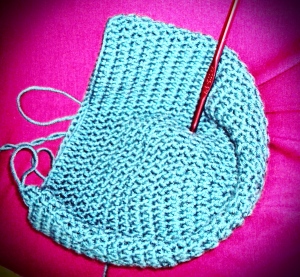Wet blocking is basically a highly controlled version of what happens when you put a wool sweater in the washing machine. You take all your hard work, swish it around in some warm sudsy water, tug on it a little, and when it dries it looks finished and professional.
I am explaining how I personally wet block. This works great for me, and blocking can really transform something that isn’t laying quite right.
Fill up a clean sink or a small washtub with warm water. If you wouldn’t bathe an infant in it, it’s too hot. Add a dab of wool soap if you have it. If you don’t, do what I do and add a dab of gentle shampoo. Hair’s a natural fiber too. You don’t want bubbles, a drop the size of a dime is more than enough.
Dunk your piece into the tub and swish it around. Be gentle; you aren’t trying to felt, you just want to get it good and wet. Don’t scrub it, just submerge and swish.
Drain the tub and fill it with cool water. Gently swish your piece again to get the suds out. Drain the tub and press your piece to get out some water.
You’ll need a bit of space for the next part. Spread out a towel and lay your piece out on a flat surface (like the floor). Roll it up and squeeze to get out some water. Treat it like fancy lingerie, roll don’t wring.
Spread out another towel and lay your piece out again. If it’s still wet, do another roll-up.
Once your piece isn’t dripping, begin shaping. First, give a little tug on all the corners to “set” your stitches. Next, do whatever to make it look the way you want. Squeeze those ribbed cuffs in your hand to make them tighter. Stretch out that wonky sleeve. Grab some pins and tack down any rolling corners, or use them to stretch out lace stitches. At this stage you should be able to mold your work like bread dough, but be gentle! It still has limits.
After you’ve got all the dimensions and stitches looking just like you want, leave your piece to dry. This could take a day or two. But when you’re done, it will look finished and fabulous!
::Note:: Blocking only works with natural fibers. I use the same method with pure wool, linen, whatever. But if you’re nervous about blocking a delicate yarn, look up steam blocking, or just try pinning the piece in place and misting with a spray bottle.
Hope this helps!









